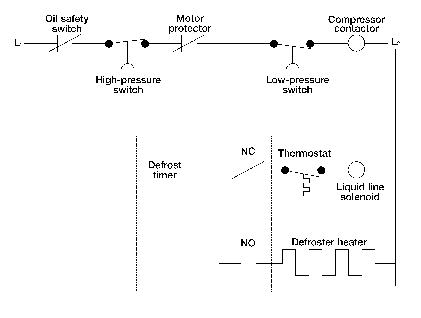In this month’s column, we will look at the different types of automatic pumpdown control systems.

AUTOMATIC PUMPDOWN ON THE ONSET OF ELECTRIC DEFROST CYCLES
An automatic pumpdown can be used on electrical defrost systems in order to prevent the refrigerant from migrating to the suction line, compressor, and oil while in defrost.During defrost, the evaporator is full of liquid and vapor refrigerant. Once the defrost heaters energize, this refrigerant will be driven toward the compressor, trying to seek a lower pressure. When the defrost terminates and the compressor starts back up, there will be enough refrigerant in the suction line and compressor’s crankcase to damage the compressor.
By pumping all of the refrigerant out of the evaporator before or during defrost, the compressor will be protected from slugging refrigerant and oil. This process prevents oil foaming from refrigerant migration to the crankcase and slugging of refrigerant from the suction line at start-ups after the defrost cycle.
Pumpdown during defrost will also shorten the defrost time because the heat of defrost can be used to melt ice and not to vaporize refrigerant left in the evaporator. This system will also perform an automatic pumpdown before every off cycle because of the solenoid valve also being in series with the box thermostat.
Figure 1 shows an electrical diagram of an automatic pumpdown system that initiates during defrost or when the thermostat opens for an off-cycle. Note the normally closed contacts of the defrost timer in series with the box control thermostat and the liquid line solenoid. When defrost calls, the normally closed contacts will open. This action will de-energize the solenoid valve and start a pumpdown. At the same time, the normally open contacts of the defrost timer will close and energize the defrost heaters. Once pumpdown during defrost is complete, a low-pressure switch will open the compressor circuit.
There will be a short time during defrost when the compressor and defrost heaters are on at the same time. It is of utmost importance that you size the fuses to carry the current of both the compressor and defrost heaters. They will both be operating until the low-pressure switch opens and shuts the compressor off.

AUTOMATIC PUMPDOWN USING A DOUBLE-ACTING LOW-PRESSURE SWITCH
Another option for pumpdown during defrost is to use a double-acting low-pressure switch. This type of pumpdown operates the same as the above-mentioned system except that the double-acting low-pressure switch will shut off the compressor and turn on the defrost heaters at the same time. This action prevents the compressor and defrost heater from ever being energized at the same time. This is accomplished by a set of normally closed and normally open set of contacts within the low-pressure switch. (See Figure 2.)This type of setup will eliminate the high amp draw from both the compressor and defrost heaters being on at the same time. This system will also perform an automatic pumpdown before every off cycle because the box thermostat is in series with the liquid line solenoid.

NON-RECYCLING AUTOMATIC PUMPDOWN SYSTEM USING A LATCHING RELAY
Once a system is pumped down, it should stay pumped down until the thermostat calls for cooling and energizes the liquid line solenoid. This action will cause the evaporator to receive refrigerant from the liquid line and increase in pressure. The low-pressure control will now close and start the compressor.However, in time, all mechanical parts will fail. Liquid line solenoid valves can leak, causing compressors to short cycle on their low-pressure control while in pumpdown. Discharge valves can also leak and cause refrigerant pressure to build in the crankcase, which can short cycle compressors on their low-pressure controls while in pumpdown. Cylinder unloading devices are also known to leak and short cycle compressors while in pumpdown.
Serious compressor motor damage and contactor damage can result if the short cycling continues unchecked for any period of time. A major compressor manufacturer has remedied the problem of short cycling during pumpdown from leaking components by designing a non-short-cycling pumpdown circuit using a latching relay. (See Figure 3, which shows the system in a pumpdown with the compressor off.)
On a call for cooling, the thermostat closes and energizes the liquid line solenoid. This allows the low side of the system to experience refrigerant pressure. This will allow the low-pressure switch to close. The latching relay coil (LRC) will now be energized through the normally closed contacts A and B. Once the latching relay coil (LRC) is energized, it will close contacts B and C and contacts C and D, while opening contacts A and B. With the LRC energized, the compressor contactor (CC) will be energized through contacts C and D and the low-pressure switch. This will start the compressor.
The system will be in a normal cooling cycle. When the thermostat is satisfied and opens, the liquid line solenoid is de-energized. This physically closes off the liquid line and initiates an automatic pumpdown. The low-pressure switch will soon open, de-energizing the CC, which will shut off the compressor. The system will now be pumped down. The compressor will remain off until there is another call for cooling from the thermostat.
If, however, the low-pressure control tries to close from a leaking component while the thermostat is still open and not calling for cooling, the CC will not be energized because of the normally open contacts C and D of the latching relay. This will prevent short cycling. The LRC will also not be allowed to be energized because of the normally open contacts B and C of the latching relay. These latching relay contacts prevent compressor short cycling during pumpdown when components leak, which causes low-side pressures to increase and low-pressure switches to close prematurely.
Tomczyk is a professor of hvac at Ferris State University, Big Rapids, MI, and author of the book, Troubleshooting and Servicing Modern Air Conditioning & Refrigeration Systems, published by ESCO Press. To order, call 800-726-9696. Tomczyk can be reached at tomczykj@tucker-usa.com.
Publication date: 12/3/2001

Report Abusive Comment